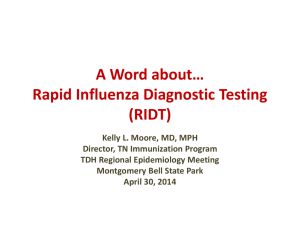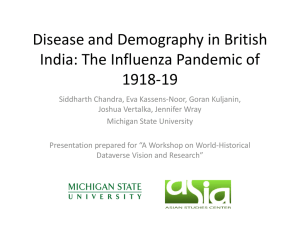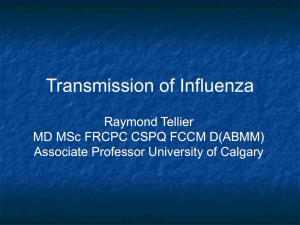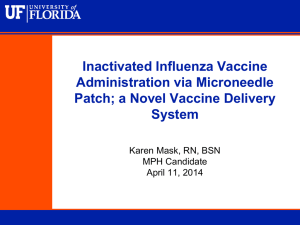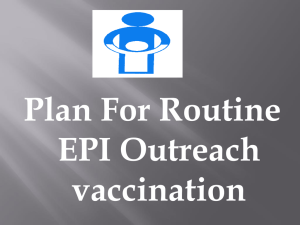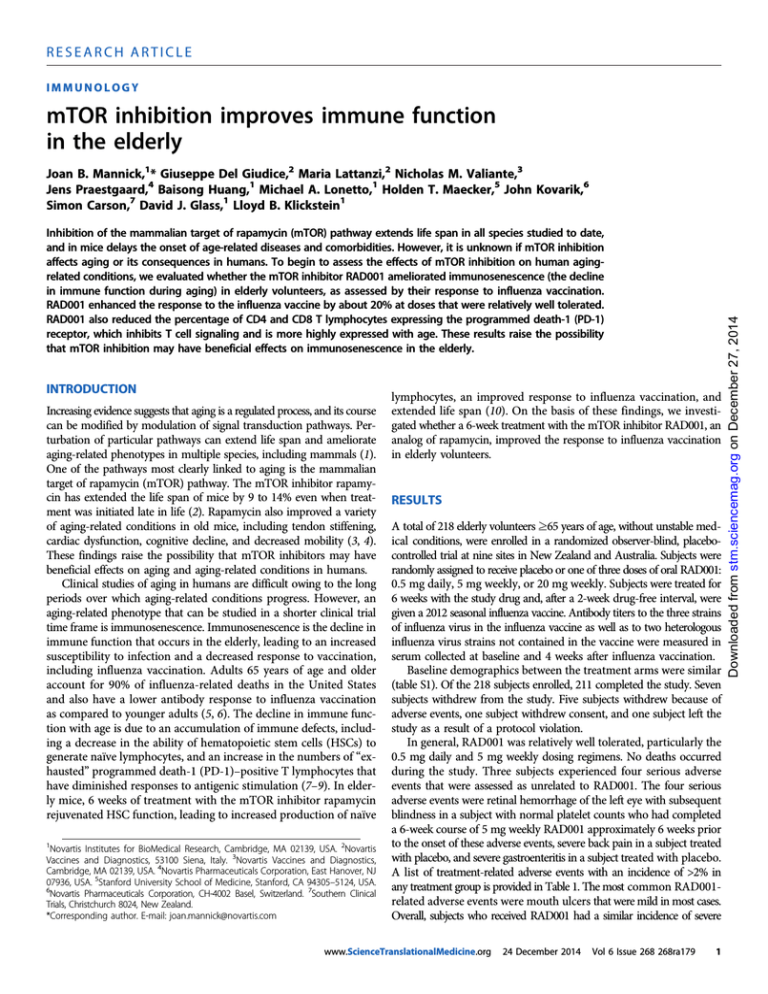
RESEARCH ARTICLE
IMMUNOLOGY
mTOR inhibition improves immune function
in the elderly
Inhibition of the mammalian target of rapamycin (mTOR) pathway extends life span in all species studied to date,
and in mice delays the onset of age-related diseases and comorbidities. However, it is unknown if mTOR inhibition
affects aging or its consequences in humans. To begin to assess the effects of mTOR inhibition on human agingrelated conditions, we evaluated whether the mTOR inhibitor RAD001 ameliorated immunosenescence (the decline
in immune function during aging) in elderly volunteers, as assessed by their response to influenza vaccination.
RAD001 enhanced the response to the influenza vaccine by about 20% at doses that were relatively well tolerated.
RAD001 also reduced the percentage of CD4 and CD8 T lymphocytes expressing the programmed death-1 (PD-1)
receptor, which inhibits T cell signaling and is more highly expressed with age. These results raise the possibility
that mTOR inhibition may have beneficial effects on immunosenescence in the elderly.
INTRODUCTION
Increasing evidence suggests that aging is a regulated process, and its course
can be modified by modulation of signal transduction pathways. Perturbation of particular pathways can extend life span and ameliorate
aging-related phenotypes in multiple species, including mammals (1).
One of the pathways most clearly linked to aging is the mammalian
target of rapamycin (mTOR) pathway. The mTOR inhibitor rapamycin has extended the life span of mice by 9 to 14% even when treatment was initiated late in life (2). Rapamycin also improved a variety
of aging-related conditions in old mice, including tendon stiffening,
cardiac dysfunction, cognitive decline, and decreased mobility (3, 4).
These findings raise the possibility that mTOR inhibitors may have
beneficial effects on aging and aging-related conditions in humans.
Clinical studies of aging in humans are difficult owing to the long
periods over which aging-related conditions progress. However, an
aging-related phenotype that can be studied in a shorter clinical trial
time frame is immunosenescence. Immunosenescence is the decline in
immune function that occurs in the elderly, leading to an increased
susceptibility to infection and a decreased response to vaccination,
including influenza vaccination. Adults 65 years of age and older
account for 90% of influenza-related deaths in the United States
and also have a lower antibody response to influenza vaccination
as compared to younger adults (5, 6). The decline in immune function with age is due to an accumulation of immune defects, including a decrease in the ability of hematopoietic stem cells (HSCs) to
generate naïve lymphocytes, and an increase in the numbers of “exhausted” programmed death-1 (PD-1)–positive T lymphocytes that
have diminished responses to antigenic stimulation (7–9). In elderly mice, 6 weeks of treatment with the mTOR inhibitor rapamycin
rejuvenated HSC function, leading to increased production of naïve
1
Novartis Institutes for BioMedical Research, Cambridge, MA 02139, USA. 2Novartis
Vaccines and Diagnostics, 53100 Siena, Italy. 3Novartis Vaccines and Diagnostics,
Cambridge, MA 02139, USA. 4Novartis Pharmaceuticals Corporation, East Hanover, NJ
07936, USA. 5Stanford University School of Medicine, Stanford, CA 94305–5124, USA.
6
Novartis Pharmaceuticals Corporation, CH-4002 Basel, Switzerland. 7Southern Clinical
Trials, Christchurch 8024, New Zealand.
*Corresponding author. E-mail: joan.mannick@novartis.com
lymphocytes, an improved response to influenza vaccination, and
extended life span (10). On the basis of these findings, we investigated whether a 6-week treatment with the mTOR inhibitor RAD001, an
analog of rapamycin, improved the response to influenza vaccination
in elderly volunteers.
RESULTS
A total of 218 elderly volunteers ≥65 years of age, without unstable medical conditions, were enrolled in a randomized observer-blind, placebocontrolled trial at nine sites in New Zealand and Australia. Subjects were
randomly assigned to receive placebo or one of three doses of oral RAD001:
0.5 mg daily, 5 mg weekly, or 20 mg weekly. Subjects were treated for
6 weeks with the study drug and, after a 2-week drug-free interval, were
given a 2012 seasonal influenza vaccine. Antibody titers to the three strains
of influenza virus in the influenza vaccine as well as to two heterologous
influenza virus strains not contained in the vaccine were measured in
serum collected at baseline and 4 weeks after influenza vaccination.
Baseline demographics between the treatment arms were similar
(table S1). Of the 218 subjects enrolled, 211 completed the study. Seven
subjects withdrew from the study. Five subjects withdrew because of
adverse events, one subject withdrew consent, and one subject left the
study as a result of a protocol violation.
In general, RAD001 was relatively well tolerated, particularly the
0.5 mg daily and 5 mg weekly dosing regimens. No deaths occurred
during the study. Three subjects experienced four serious adverse
events that were assessed as unrelated to RAD001. The four serious
adverse events were retinal hemorrhage of the left eye with subsequent
blindness in a subject with normal platelet counts who had completed
a 6-week course of 5 mg weekly RAD001 approximately 6 weeks prior
to the onset of these adverse events, severe back pain in a subject treated
with placebo, and severe gastroenteritis in a subject treated with placebo.
A list of treatment-related adverse events with an incidence of >2% in
any treatment group is provided in Table 1. The most common RAD001related adverse events were mouth ulcers that were mild in most cases.
Overall, subjects who received RAD001 had a similar incidence of severe
www.ScienceTranslationalMedicine.org
24 December 2014
Vol 6 Issue 268 268ra179
1
Downloaded from stm.sciencemag.org on December 27, 2014
Joan B. Mannick,1* Giuseppe Del Giudice,2 Maria Lattanzi,2 Nicholas M. Valiante,3
Jens Praestgaard,4 Baisong Huang,1 Michael A. Lonetto,1 Holden T. Maecker,5 John Kovarik,6
Simon Carson,7 David J. Glass,1 Lloyd B. Klickstein1
RESEARCH ARTICLE
Table 1. Incidence of treatment-related adverse events >2% in any treatment group.
RAD001, 0.5 mg daily
(N = 53)
RAD001, 5 mg weekly
(N = 53)
RAD001, 20 mg weekly
(N = 53)
Placebo, pooled
(N = 59)
Total
(N = 218)
Total adverse events
Subjects with adverse events
Mouth ulceration
Headache
35
46
109
21
211
22 (41.5)
20 (37.7)
27 (50.9)
12 (20.3)
81 (37.2)
6 (11.3)
2 (3.8)
9 (17.0)
3 (5.1)
20 (9.2)
0
2 (3.8)
9 (17.0)
1 (1.7)
12 (5.5)
Blood cholesterol increased
2 (3.8)
2 (3.8)
2 (3.8)
0
6 (2.8)
Diarrhea
1 (1.9)
4 (7.5)
1 (1.9)
0
6 (2.8)
Dyspepsia
0
3 (5.7)
2 (3.8)
1 (1.7)
6 (2.8)
Fatigue
0
2 (3.8)
4 (7.5)
0
6 (2.8)
2 (3.8)
1 (1.9)
2 (3.8)
0
5 (2.3)
Low-density lipoprotein increased
Tongue ulceration
3 (5.7)
1 (1.9)
0
1 (1.7)
5 (2.3)
Insomnia
1 (1.9)
2 (3.8)
1 (1.9)
0
4 (1.8)
0
0
2 (3.8)
1 (1.7)
3 (1.4)
Dry mouth
Neutropenia
0
0
3 (5.7)
0
3 (1.4)
Oral pain
0
2 (3.8)
1 (1.9)
0
3 (1.4)
Pruritus
0
2 (3.8)
1 (1.9)
0
3 (1.4)
Conjunctivitis
0
2 (3.8)
0
0
2 (0.9)
Erythema
0
2 (3.8)
0
0
2 (0.9)
Limb discomfort
0
2 (3.8)
0
0
2 (0.9)
Mucosal inflammation
0
0
2 (3.8)
0
2 (0.9)
2 (3.8)
0
0
0
2 (0.9)
Paresthesia (oral)
Stomatitis
0
0
2 (3.8)
0
2 (0.9)
Thrombocytopenia
0
0
2 (3.8)
0
2 (0.9)
Urinary tract infection
0
0
2 (3.8)
0
2 (0.9)
adverse events as those treated with placebo. Only one severe adverse
event was assessed as related to RAD001: mouth ulcers in a subject treated
with 20 mg weekly RAD001.
The ability of RAD001 to improve immune function in elderly volunteers was evaluated by measuring the serologic response to the 2012 seasonal influenza vaccine. The increase in hemagglutination inhibition
(HI) titers per subject and the geometric mean titers (GMTs) to each of
the three influenza vaccine strains at 4 weeks after influenza vaccination
as compared to baseline are shown in fig. S1 and table S2. The HI titer
measures the concentration of antibodies to the hemagglutinin protein
of the influenza virus. The HI titer correlates with protection against
influenza illness. HI titer values are expressed as geometric means rather
than averages because averages may be biased by a few very high titer
values. The primary analysis variable was the HI GMT ratio (4 weeks after
vaccination/baseline). The study was powered to be able to demonstrate
that in at least two of three influenza vaccine strains, there was a ≥1.2-fold
GMT ratio increase relative to placebo and a posterior probability of at
least 80% that the placebo-corrected GMT ratio exceeded 1.0. This
endpoint was chosen because an about 1.2-fold increase in the influenza
GMT ratio induced by the MF59 vaccine adjuvant was associated with a
decrease in influenza illness (11).
In the intent-to-treat population, the low-dose RAD001 (0.5 mg daily or
5 mg weekly) cohorts, but not the higher-dose (20 mg weekly) cohort, met
the primary endpoint of the study (Fig. 1A). Modeling and simulation
based on mTOR-mediated phosphorylation of its downstream target S6
kinase (S6K) predicted that the 20 mg weekly dosing regimen inhibited
mTOR-mediated S6K phosphorylation almost completely, the 5 mg weekly
dosing regimen inhibited S6K phosphorylation by more than 50%, and the
0.5 mg daily dosing regimen inhibited S6K phosphorylation by about 38%
over the dosing interval (12). Thus, partial inhibition of mTOR-mediated
S6K phosphorylation achieved with a relatively low dose of RAD001 may
be as effective as nearly complete inhibition associated with high-dose
RAD001 at enhancing the immune response of the elderly volunteers.
In a subgroup analysis, the subset of subjects with low baseline influenza
titers (≤1:40) experienced a greater RAD001-associated increase in titers
than did the entire intent-to-treat population (Fig. 1B). These data suggested
that RAD001 may have been particularly effective at enhancing the influenza vaccine response of subjects who did not have protective (>1:40)
titers at baseline and therefore were at greater risk of influenza illness.
Rates of seroconversion 4 weeks after influenza vaccination also were
evaluated. Seroconversion was defined as the change from a negative
prevaccination titer (that is, HI titer <1:10) to a postvaccination HI titer
www.ScienceTranslationalMedicine.org
24 December 2014
Vol 6 Issue 268 268ra179
2
Downloaded from stm.sciencemag.org on December 27, 2014
n (%)
serologic response to influenza (13). The
broader serologic response included antibodies to conserved epitopes expressed
by multiple subtypes of influenza that
provided protection against infection
with heterologous strains of influenza
virus not contained in the vaccine (13).
To determine whether RAD001 treatment broadened the serologic response
to influenza in the elderly volunteers,
we measured HI titers to two heterologous
strains of influenza not contained in the
seasonal influenza vaccine (A/H1N1 strain
A/New Jersey/8/76 and A/H3N2 strain
A/Victoria/361/11). The increase in the
HI GMT ratio (4 weeks after vaccination/
baseline) for the heterologous strains was
higher in the RAD001-treated cohorts
compared to the placebo cohort (Fig. 2).
In addition, seroconversion rates for the
heterologous strains were higher in the
RAD001-treated cohorts compared to
the placebo cohort. The increase in seroconversion rates in the 5 and 20 mg RAD001
weekly dosing cohorts was statistically
significant for the H3N2 heterologous
strain (Table 3). The H3N2 seroconversion
rate for the pooled RAD001 cohorts was
39% versus 20% for the placebo cohort
(P = 0.007).
To explore the mechanism by which
RAD001 enhanced immune function in
elderly volunteers, we performed immunophenotyping on peripheral blood mononuclear cell (PBMC) samples obtained
Fig. 1. Increase in antibody titers to influenza vaccine strains in RAD001-treated versus placebo
cohorts. (A) Increase above baseline in GMTs to each of the three influenza vaccine strains (H1N1 from subjects at baseline, after 6 weeks
A/California/07/2009, H3N2 A/Victoria/210/2009, and B/Brisbane/60/ 2008) 4 weeks after vaccination in of drug treatment, and 4 weeks after inRAD001-treated cohorts relative to the placebo cohort. The fold changes in GMTs relative to the placebo fluenza vaccination (that is, 6 weeks after
cohort are shown for all of the RAD001 dosing cohorts in the intent-to-treat population. The bold black study drug discontinuation). Although the
line indicates the 1.2-fold increase in titers relative to placebo that is required for two of three influenza percentage of most PBMC subsets did not
vaccine strains in order to meet the primary endpoint of the study. Asterisks indicate that the increase in differ between the RAD001-treated and
GMT relative to placebo exceeds 1.0 with posterior probability of at least 80%. (B) The same data as in (A) placebo cohorts, the pooled RAD001 coare shown for the subset of subjects with baseline influenza titers ≤1:40.
hort had a significantly lower percentage
of PD-1–positive CD4 (P = 0.03) and
≥1:40 or at least a fourfold increase from a nonnegative (≥1:10) prevac- CD8 T cells (P = 0.008) compared to the placebo cohort after 6 weeks
cination HI titer. In the intent-to-treat population, seroconversion rates of study drug treatment (Fig. 3).
for the H3N2 and B influenza strains were increased in the RAD001treated cohorts as compared to the placebo cohorts, although the
increases did not meet statistical significance (Table 2). In the sub- DISCUSSION
population of subjects with baseline influenza titers ≤1:40, RAD001
treatment also increased the rates of seroconversion to the H3N2 and The data presented here suggest that the mTOR inhibitor RAD001
B influenza strains, and these results reached statistical significance for ameliorated the age-related decline in immunological function of
the B strain in the 0.5 mg daily dosing cohort (Table 2).
human elderly volunteers as assessed by response to influenza vacCurrent seasonal influenza vaccines often provide inadequate cination, and that this amelioration was obtained with an acceptable
protection against continuously emerging strains of influenza virus risk/benefit balance. In a study of elderly mice, treatment with the
that present as variants of previously circulating viruses. However, mTOR inhibitor rapamycin for 6 weeks not only enhanced the response
mice vaccinated against influenza in the presence of the mTOR in- to influenza vaccination but also extended life span (10). Although
hibitor rapamycin, as compared to placebo, developed a broader that was a small preclinical study that needs to be replicated, those
www.ScienceTranslationalMedicine.org
24 December 2014
Vol 6 Issue 268 268ra179
3
Downloaded from stm.sciencemag.org on December 27, 2014
RESEARCH ARTICLE
Table 2. Percentages of subjects with seroconversion to influenza
4 weeks after vaccination.
Placebo
(N = 54)
0.5 mg
(N = 48)
5 mg
(N = 49)
20 mg
(N = 48)
Intent-to-treat population (%)
H1N1
24
27
27
17
H3N2
17
27
24
25
B
17
27
22
19
Subjects with baseline titers ≤40 (%)
H1N1
40
42
45
36
H3N2
42
64
53
71
B
16
40*
33
28
results raise the possibility that amelioration of immunosenescence
may be a marker of a broader effect on aging-related phenotypes. It
remains to be determined whether RAD001 ameliorates additional
aging-related conditions beyond a diminished vaccination response
in elderly humans.
The mechanism by which RAD001 enhanced the vaccination response in the elderly volunteers warrants further investigation. Given
that RAD001 dosing was discontinued 2 weeks before vaccination, the
immune-enhancing effects of RAD001 likely were mediated by changes
in a relevant cell population that persisted after drug discontinuation.
Here, RAD001 treatment decreased the percentage of PD-1–positive
CD4 and CD8 T cells compared to placebo. PD-1–positive CD4 and
CD8 T cells accumulate with age and have diminished responses to antigen stimulation because PD-1 inhibits T cell receptor–induced T
cell proliferation, cytokine production, and cytolytic function (8).
PD-1 expression is induced by T cell signaling and remains high in the
setting of persistent antigen stimulation, including chronic viral infection. It is possible that RAD001 reduced chronic immune activation in
Fig. 2. Increase in antibody titers to heterologous influenza strains in
RAD001-treated versus placebo cohorts. Increase above baseline in the
GMTs to two heterologous influenza strains (A/H1N1 strain A/New Jersey/
8/76 and A/H3N2 strain A/Victoria/361/11) that were not contained in the
seasonal influenza vaccine for RAD001-treated relative to placebo cohorts,
4 weeks after vaccination. Asterisks indicate that the increase in GMT relative to placebo exceeded 1.0 with a posterior probability of at least 80%.
Table 3. Percentages of subjects who seroconverted to heterologous
strains of influenza 4 weeks after receiving the seasonal influenza
vaccine.
Placebo,
pooled
(%)
RAD001, RAD001,
RAD001,
0.5 mg
5 mg
20 mg
daily (%) weekly (%) weekly (%)
A/H1N1strain:
A/New Jersey/8/76
7
17
16
8
A/H3N2strain:
A/Victoria/361/11
20
38
39*
40*
*Odds ratio for seroconversion between RAD001-treated and placebo cohorts that was significantly different from 1.0 (two-sided P value <0.05 obtained by logistic regression with treatment as fixed effect).
Fig. 3. Decrease in percent of PD-1–positive CD4 and CD8 T cells after
RAD001 treatment. The percent of PD-1–positive CD4 and CD8 T cells was
determined by fluorescence-activated cell sorting analysis of PBMC samples at baseline, after 6 weeks of drug treatment (week 6), 6 weeks after
study drug discontinuation, and 4 weeks after influenza vaccination (week 12).
(A) There was a significant decrease of 30.2% in PD-1–positive CD4 T cells at
week 6 in the pooled RAD001-treated cohort (n = 84) compared to the
placebo cohort (n = 25) [P = 0.03 (q = 0.13)]. The decrease in PD-1–positive
CD4 T cells at week 12 in the pooled RAD001-treated cohort compared to
the placebo cohort was 32.7% [P = 0.05 (q = 0.19)]. (B) There was a significant
decrease of 37.4% in PD-1–positive CD8 T cells at week 6 in the pooled
RAD001-treated cohort (n = 84) compared to the placebo cohort (n = 25)
[P = 0.008 (q = 0.07)]. The decrease in PD-1–positive CD8 T cells at week 12 in
the pooled RAD001-treated cohort compared to the placebo cohort was
41.4% [P = 0.066 (q = 0.21)].
www.ScienceTranslationalMedicine.org
24 December 2014
Vol 6 Issue 268 268ra179
4
Downloaded from stm.sciencemag.org on December 27, 2014
RESEARCH ARTICLE
elderly volunteers and thereby led to a decrease in PD-1 expression.
RAD001 also may have inhibited PD-1 expression directly, as has
been reported for the immunophilin cyclosporin A (14). A RAD001associated decrease in the percentage of PD-1–positive CD4 and
CD8 T cells may contribute to enhanced immune function and improve the quality of T cell responses to antigenic stimulation in
the elderly. This is consistent with previous studies showing that
mTOR inhibition improved the quality of memory CD8 T cell responses to vaccination in mice and primates (15). In our study, there
was an increase in the percentage of PD-1–positive T cells over time in
the placebo cohort but not in the pooled RAD001 cohort. At week 12
(4 weeks after vaccination), the increase in the placebo cohort may
have been due in part to influenza vaccination because influenza virus
has been shown to increase PD-1–positive T cells (16). In aged mice,
mTOR inhibition also has been shown to increase the number of
HSCs, leading to increased production of naïve lymphocytes (10).
However, in this study, we did not detect significant differences in
the percentage of naïve lymphocytes in the RAD001-treated versus
placebo cohorts.
Our results also suggest that mTOR inhibition broadened the serologic response of elderly volunteers to influenza vaccination and
increased antibody titers to heterologous strains of influenza not
contained in the seasonal influenza vaccine. The mechanism by
which RAD001 broadened the serologic response to heterologous
strains of influenza virus remains to be determined. In a previous
study in which mice were dosed with rapamycin for 28 days
beginning 1 day before influenza infection, the broadened serologic
response to heterologous influenza strains may have been due in part
to inhibition of B cell class switching by rapamycin (13). In contrast,
we did not find evidence that RAD001 altered B cell class switching in
our elderly subjects who had discontinued RAD001 2 weeks before influenza vaccination (fig. S2). Although the underlying mechanism requires further elucidation, an increased serologic response to
heterologous influenza strains may confer enhanced protection against
influenza illness.
The effect of RAD001 on influenza antibody titers was comparable to the effect of the MF59 vaccine adjuvant, which is approved for
enhancing the response of the elderly to influenza vaccination (17).
Therefore, RAD001-driven enhancement of the antibody response to
influenza vaccination may translate into clinical benefit as has been
demonstrated for MF59-adjuvanted influenza vaccine in the elderly
(11). However, RAD001 also is used to suppress the immune response
to prevent rejection of transplanted organs. These seemingly paradoxical findings raise the possibility that the immunomodulatory effects of
mTOR inhibitors may be dependent on age, disease, and/or antigen
(18). Notably, mTOR activity is increased in a variety of tissues including HSCs in animal models of aging (10, 19). Thus, down-regulating
mTOR activity to levels seen in young tissues, as opposed to more
complete suppression of mTOR activity, may be required to obtain
clinical benefit in aging-related conditions.
The limitations of our study include the relatively small sample
size for a human influenza vaccination study, which limits statistical
power. In addition, evaluation of immune function was limited to assessment of vaccination response and immunophenotyping and did not
include assessments of cell-mediated immune function. Finally, we did
not evaluate the effect of mTOR inhibitors on vaccination responses in
a young cohort, so we do not know if mTOR inhibitors improve immune function in both the young and the old. However, the RAD001-
associated decrease in the percentage of PD-1–positive T cells is likely to
benefit immune function more in the elderly than in the young because
PD-1–positive T cells accumulate with age. Finally, this was an exploratory proof-of-concept study that used a liberal preplanned threshold for
significance (80% posterior probability of an effect over placebo). The
hypotheses generated concerning the immune-enhancing effects of
mTOR inhibitors need to be verified with additional studies.
The safety profile of mTOR inhibitors such as RAD001 in the
treatment of aging-related indications has been of concern. The toxicity
of RAD001 at doses used in oncology or organ transplantation results in
adverse effects such as stomatitis, diarrhea, nausea, cytopenias, hyperlipidemia, and hyperglycemia, which would be unacceptable for many
aging-related indications. However, many of these adverse events are related to the pre-dose (trough) concentrations of RAD001 in blood. The
RAD001 dosing regimens used in this study were chosen to minimize
trough concentrations of the drug. In addition, the limited 6-week course
of treatment decreased the risk of adverse events. Thus, our findings suggest that the dosing regimens used in this study may have an acceptable
risk/benefit for treating some conditions of the elderly. Nonetheless, significant numbers of subjects in our study developed mouth ulcers even
when dosed as low as 0.5 mg RAD001 daily, although most mouth ulcers were transient and of mild severity. Development of mTOR inhibitors with cleaner safety profiles than the currently available rapalogs may
provide better therapeutic options for boosting immune responses in the
elderly in the future.
MATERIALS AND METHODS
Study design
From December 2011 to April 2012, 218 elderly volunteers ≥65 years
of age without unstable underlying medical diseases were enrolled in a
randomized, observer-blind, placebo-controlled trial at nine sites in
New Zealand and Australia. The objective of the study was to determine
if RAD001 enhanced immune function in the elderly as assessed by
response to influenza vaccination. Response to influenza was assessed
by measuring HI titers to the three influenza strains in the 2012 influenza vaccine at baseline and 4 weeks after vaccination. Exclusion
criteria at screening included hemoglobin <9.0 g/dl, white blood cell
count <3500/mm3, neutrophil count <2000/mm3, or platelet count
<125,000/mm3; uncontrolled diabetes; unstable ischemic heart disease;
clinically significant underlying pulmonary disease; history of an immunodeficiency or receiving immunosuppressive therapy; history of
coagulopathy or medical condition requiring long-term anticoagulation;
estimated glomerular filtration rate <30 ml/min; and presence of severe
uncontrolled hypercholesterolemia (>350 mg/dl, 9.1 mM) or hypertriglyceridemia (>500 mg/dl, 5.6 mM).
The subjects were randomized to treatment arms, using a validated
automated randomization system with a ratio of RAD001 to placebo
of 5:2 in each treatment arm. The treatment arms were as follows:
0.5 mg RAD001 daily or placebo, 5 mg RAD001 weekly or placebo, or
20 mg RAD001 weekly or placebo. The trial was observer-blind because the placebo in the RAD001 0.5 mg daily and 20 mg weekly cohorts differed slightly from the RAD001 tablets in those cohorts. The
study personnel evaluating the subjects did not see the study medication
and therefore were fully blinded. The treatment duration for all cohorts
was 6 weeks, during which time subjects underwent safety evaluations in the clinic every 2 weeks. After the subjects had been dosed for
www.ScienceTranslationalMedicine.org
24 December 2014
Vol 6 Issue 268 268ra179
5
Downloaded from stm.sciencemag.org on December 27, 2014
RESEARCH ARTICLE
RESEARCH ARTICLE
Safety
Adverse event assessment and blood collection for hematologic and
biochemical safety assessments were performed during study visits.
Adverse event information was also collected in diaries that subjects filled
out at home during the 6 weeks they were on study drug. Data on all
adverse events were collected from the time of informed consent until
30 days after the last study visit. Events were classified by the investigators as mild, moderate, or severe.
Immunophenotyping
PBMCs were isolated from whole blood collected at three time points:
baseline, after 6 weeks of study drug treatment, and at the end of study
when subjects had been off study drug for 6 weeks and 4 weeks after
influenza vaccination. Immunophenotyping was performed at the
Human Immune Monitoring Center at Stanford University, Stanford,
CA, as described previously (22). Seventy-six PBMC subsets were analyzed by flow cytometry with eight-color lyophilized immunophenotyping panels (BD Lyoplate, BD Biosciences). PBMC samples with
viability ≥80% and yield of 2 × 106 cells/ml or more were included
in the analysis.
To determine which immunophenotype changes differed between
the treated and placebo groups, within-patient cell count ratios for each
measured phenotype were calculated between baseline and week 6 of
study drug treatment and between baseline and the end of study (week
12). The ratios were log-transformed and analyzed by analysis of covariance at each time point to detect a difference between the pooled
treatment and placebo groups. For this analysis, all three RAD001 dosing groups were combined. Before the analysis, low-viability samples
were removed, and we did not conduct missing data imputation in
treatment effect analysis. Therefore, if a patient had missing phenotype data at baseline, week 6, or week 12, this patient did not contribute to the analysis of this phenotype for the affected time point.
In the end, we conducted 152 tests in 76 phenotypes to compare
the pooled treatment effect against the placebo effect. Stratified false
discovery rate (FDR) control methodology was implemented to control the occurrence of false positives associated with multiple testing
yet provide considerably better power (23, 24). We took the cell type
group as the stratification factor and conducted FDR (q value) calculation within each stratum respectively. We rejected all null hypothe-
ses at 0.05 significance level and q value less than 20%. This can be
interpreted as rejecting only those hypotheses with P values less than
0.05 and less than 20% probability that each observed significant result
is due to multiple testing.
Statistical analysis
The primary analysis of GMT ratios was done using a normal Bayesian
regression model with noninformative priors. This model was fitted
to each antibody titer on the log scale. The primary outcome in each
model was the day 84 (4 weeks after vaccination) measurement. The
day 63 (1 week after vaccination) measurement was included in the
outcome vector. The model was fitted using SAS 9.2 PROC mixed
with the prior statement. The covariance structure of the matrix
was considered as unstructured (option type = UN). A flat prior was
used. For the secondary analysis of seroconversion rates, logistic regression was used. The intent-to-treat population was defined as all subjects
who received at least one full dose of the study drug and who had no
major protocol deviations affecting efficacy data. Of the total of 218
subjects enrolled in the study, 199 were in the intent-to-treat population.
SUPPLEMENTARY MATERIALS
www.sciencetranslationalmedicine.org/cgi/content/full/6/268/268ra179/DC1
Table S1. Demographic and baseline characteristics of the study subjects.
Table S2. HI GMTs for each influenza vaccine strain at baseline and at 4 weeks after influenza
vaccination.
Fig. S1. Individual subject HI titer ratios (4 weeks after vaccination/baseline) per cohort for the
three influenza vaccine strains and two heterologous influenza strains.
Fig. S2. Increase in anti-H1N1 influenza IgG and IgM after influenza vaccination.
REFERENCES AND NOTES
1. S. C. Johnson, G. M. Martin, P. S. Rabinovitch, M. Kaeberlein, Preserving youth: Does rapamycin
deliver? Sci. Transl. Med. 5, 211fs40 (2013).
2. D. E. Harrison, R. Strong, Z. D. Sharp, J. F. Nelson, C. M. Astle, K. Flurkey, N. L. Nadon, J. E. Wilkinson,
K. Frenkel, C. S. Carter, M. Pahor, M. A. Javors, E. Fernandez, R. A. Miller, Rapamycin fed late in
life extends lifespan in genetically heterogeneous mice. Nature 460, 392–395 (2009).
3. J. E. Wilkinson, L. Burmeister, S. V. Brooks, C. C. Chan, S. Friedline, D. E. Harrison, J. F. Hejtmancik,
N. Nadon, R. Strong, L. K. Wood, M. A. Woodward, R. A. Miller, Rapamycin slows aging in mice.
Aging Cell 11, 675–682 (2012).
4. J. M. Flynn, M. N. O’Leary, C. A. Zambataro, E. C. Academia, M. P. Presley, B. J. Garrett, A. Zykovich,
S. D. Mooney, R. Strong, C. J. Rosen, P. Kapahi, M. D. Nelson, B. K. Kennedy, S. Melov, Latelife rapamycin treatment reverses age-related heart dysfunction. Aging Cell 12, 851–862
(2013).
5. W. W. Thompson, D. K. Shay, E. Weintraub, L. Brammer, N. Cox, L. J. Anderson, K. Fukuda,
Mortality associated with influenza and respiratory syncytial virus in the United States. JAMA
289, 179–186 (2003).
6. K. Goodwin, C. Viboud, L. Simonsen, Antibody response to influenza vaccination in the
elderly: A quantitative review. Vaccine 24, 1159–1169 (2006).
7. D. Boraschi, M. T. Aguado, C. Dutel, J. Goronzy, J. Louis, B. Grubeck-Loebenstein, R. Rappuoli,
G. Del Giudice, The gracefully aging immune system. Sci. Transl. Med. 5, 185ps8 (2013).
8. C. S. Lages, I. Lewkowich, A. Sproles, M. Wills-Karp, C. Chougnet, Partial restoration of T cell
function in aged mice by in vitro blockade of the PD-1/PD-L1 pathway. Aging Cell 9, 785–798
(2010).
9. K. Shimatani, Y. Nakashima, M. Hattori, Y. Hamazaki, N. Minato, PD-1+ memory phenotype
CD4+ T cells expressing C/EBPa underlie T cell immunodepression in senescence and leukemia. Proc. Natl. Acad. Sci. U.S.A. 106, 15807–15812 (2009).
10. C. Chen, Y. Liu, Y. Liu, P. Zheng, mTOR regulation and therapeutic rejuvenation of aging
hematopoietic stem cells. Sci. Signal. 2, ra75 (2009).
11. A. Iob, G. Brianti, E. Zamparo, T. Gallo, Evidence of increased clinical protection of an MF59adjuvant influenza vaccine compared to a non-adjuvant vaccine among elderly residents
of long-term care facilities in Italy. Epidemiol. Infect. 133, 687–693 (2005).
www.ScienceTranslationalMedicine.org
24 December 2014
Vol 6 Issue 268 268ra179
6
Downloaded from stm.sciencemag.org on December 27, 2014
4 weeks, RAD001 steady-state levels were measured pre-dose and at
1 hour post-dose. After the subjects completed the 6-week course of
study drug, they were given a 2-week drug-free break and then were
given a 2012 seasonal influenza vaccination (Agrippal, Novartis Vaccines and Diagnostics) containing the strains H1N1 A/California/07/
2009, H3N2 A/Victoria/210/2009, and B/Brisbane/60/2008. Four weeks
after influenza vaccination, serum was collected from the subjects
for influenza titer measurements. Antibody titers to the three influenza vaccine strains as well as to two heterologous strains (A/H1N1
strain A/New Jersey/8/76 and A/H3N2 strain A/Victoria/361/11) were
measured by standard HI assay (20). Levels of immunoglobulin G
(IgG) and IgM specific for the A/H1N1/California/07/2009 were measured in serum samples taken before and 4 weeks after influenza vaccination by the Gyrolab technology as described previously (21). Results
were expressed as fluorescence intensity. All subjects provided written
informed consent. The study was conducted in accordance with the
principles of Good Clinical Practice and was approved by the appropriate ethics committees and regulatory agencies.
RESEARCH ARTICLE
ICOS1+IL-21+ T cells expand after vaccination, exert helper function, and predict antibody
responses. Proc. Natl. Acad. Sci. U.S.A. 110, 14330–14335 (2013).
22. H. T. Maecker, J. P. McCoy, R. Nussenblatt, Standardizing immunophenotyping for the Human
Immunology Project. Nat. Rev. Immunol. 12, 191–200 (2012).
23. Y. Benjamini, Y. Hochberg, Controlling the false discovery rate: A practical and powerful
approach to multiple testing. J. R. Statist. Soc. B 57, 289–300 (1995).
24. L. Sun, R. V. Craiu, A. D. Paterson, S. B. Bull, Stratified false discovery control for large-scale
hypothesis testing with application to genome-wide association studies. Genet. Epidemiol.
30, 519–530 (2006).
Acknowledgments: We thank the volunteers, investigators, and site staff who participated in
this study, including D. Quinn, M. Williams, H. Blom, D. Millar-Coote, J. Bramston, R. Nalder, and G. Foley.
We also thank the staff of Pharmaceutical Solutions, particularly E. Gent. Funding: Supported by
Novartis Institutes for BioMedical Research. Author contributions: J.B.M. designed the study, analyzed the data, and wrote the paper; G.D.G., M.L., and N.M.V. designed the study and analyzed the
data; J.P., B.H., and M.A.L. performed the statistical analysis of the data; H.T.M. designed and performed the immunophenotyping experiments; J.K. performed the pharmacokinetic analysis; S.C.
was the lead clinical investigator on the study and generated the clinical data; D.J.G. analyzed the
data; and L.B.K. designed the study and analyzed the data. Competing interests: J.B.M., G.D.G., M.L.,
N.M.V., J.P., B.H., M.L., J.K. D.J.G., and L.B.K. have equity interest in Novartis, which developed RAD001.
Submitted 24 June 2014
Accepted 3 December 2014
Published 24 December 2014
10.1126/scitranslmed.3009892
Citation: J. B. Mannick, G. Del Giudice, M. Lattanzi, N. M. Valiante, J. Praestgaard, B. Huang,
M. A. Lonetto, H. T. Maecker, J. Kovarik, S. Carson, D. J. Glass, L. B. Klickstein, mTOR inhibition
improves immune function in the elderly. Sci. Transl. Med. 6, 268ra179 (2014).
www.ScienceTranslationalMedicine.org
24 December 2014
Vol 6 Issue 268 268ra179
7
Downloaded from stm.sciencemag.org on December 27, 2014
12. C. Tanaka, T. O’Reilly, J. M. Kovarik, N. Shand, K. Hazell, I. Judson, E. Raymond, S. Zumstein-Mecker,
C. Stephan, A. Boulay, M. Hattenberger, G. Thomas, H. A. Lane, Identifying optimal biologic
doses of everolimus (RAD001) in patients with cancer based on the modeling of preclinical
and clinical pharmacokinetic and pharmacodynamic data. J. Clin. Oncol. 26, 1596–1602
(2008).
13. R. Keating, T. Hertz, M. Wehenkel, T. L. Harris, B. A. Edwards, J. L. McClaren, S. A. Brown,
S. Surman, Z. S. Wilson, P. Bradley, J. Hurwitz, H. Chi, P. C. Doherty, P. G. Thomas, M. A. McGargill,
The kinase mTOR modulates the antibody responses to provide cross-protective immunity
to lethal infection with influenza virus. Nat. Immunol. 14, 1266–1276 (2013).
14. K. J. Oestreich, H. Yoon, R. Ahmed, J. M. Boss, NFATc1 regulates PD-1 expression upon T
cell activation. J. Immunol. 181, 4832–4839 (2008).
15. K. Araki, A. P. Turner, V. O. Shaffer, S. Gangappa, S. A. Keller, M. F. Bachmann, C. P. Larsen,
R. Ahmed, mTOR regulates memory CD8 T-cell differentiation. Nature 460, 108–112 (2009).
16. J. J. Erickson, P. Gilchuk, A. K. Hastings, S. J. Tollefson, M. Johnson, M. B. Downing, K. L. Boyd,
J. E. Johnson, A. S. Kim, S. Joyce, J. V. Williams, Viral acute lower respiratory infections impair
CD8+ T cells through PD-1. J. Clin. Invest. 122, 2967–2982 (2012).
17. A. Podda, The adjuvanted influenza vaccines with novel adjuvants: Experience with the
MF59-adjuvanted vaccine. Vaccine 19, 2673–2680 (2001).
18. I. R. Ferrer, M. E. Wagener, J. M. Robertson, A. P. Turner, K. Araki, R. Ahmed, A. D. Kirk,
C. P. Larsen, M. L. Ford, Cutting edge: Rapamycin augments pathogen-specific but not
graft-reactive CD8+ T cell responses. J. Immunol. 185, 2004–2008 (2010).
19. M. Barns, C. Gondro, R. L. Tellam, H. G. Radley-Crabb, M. D. Grounds, T. Shavlakadze, Molecular
analyses provide insight into mechanisms underlying sarcopenia and myofibre denervation in
old skeletal muscles of mice. Int. J. Biochem. Cell Biol. 53, 174–185 (2014).
20. Centers for Disease Control and Prevention, Haemagglutination inhibition, in Concepts and
Procedures for Laboratory-Based Influenza Surveillance, A. P. Kendal, M. S. Pereira, J. J. Skehel,
Eds. (Centers for Disease Control and Prevention, Atlanta, GA, 2010) pp. B17–B35.
21. F. Spensieri, E. Borgogni, L. Zedda, M. Bardelli, F. Buricchi, G. Volpini, E. Fragapane, S. Tavarini,
O. Finco, R. Rappuoli, G. Del Giudice, G. Galli, F. Castellino, Human circulating influenza-CD4+
mTOR inhibition improves immune function in the elderly
Joan B. Mannick et al.
Sci Transl Med 6, 268ra179 (2014);
DOI: 10.1126/scitranslmed.3009892
Editor's Summary
mTOR and Human Aging
A complete electronic version of this article and other services, including high-resolution figures,
can be found at:
http://stm.sciencemag.org/content/6/268/268ra179.full.html
Supplementary Material can be found in the online version of this article at:
http://stm.sciencemag.org/content/suppl/2014/12/19/6.268.268ra179.DC1.html
Information about obtaining reprints of this article or about obtaining permission to reproduce this
article in whole or in part can be found at:
http://www.sciencemag.org/about/permissions.dtl
Science Translational Medicine (print ISSN 1946-6234; online ISSN 1946-6242) is published weekly, except the
last week in December, by the American Association for the Advancement of Science, 1200 New York Avenue
NW, Washington, DC 20005. Copyright 2014 by the American Association for the Advancement of Science; all
rights reserved. The title Science Translational Medicine is a registered trademark of AAAS.
Downloaded from stm.sciencemag.org on December 27, 2014
Inhibition of mTOR signaling extends life span and delays the onset of aging-related diseases in all species
studied to date. These findings suggest that the mTOR pathway regulates aging. However, it is unknown if mTOR
inhibition has beneficial effects on aging in humans. To begin to address this question, Mannick et al. evaluated the
effects of the mTOR inhibitor RAD001 on the decline in immune function that occurs during aging in humans. Their
findings suggest that RAD001 improved immune function in elderly volunteers as assessed by response to influenza
vaccination. It remains to be determined whether mTOR inhibition improves additional aging-related conditions in
humans.



